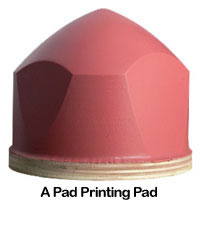|
 Pad
printing is a printing process that can transfer a 2-D image
onto a 3-D object. This is accomplished using an indirect
offset (gravure) printing process that involves an image being
transferred from the printing plate (cliché) via a
silicone pad onto a substrate (surface to be printed). Pad
printing is used for printing on otherwise impossible products
in many industries including medical, automotive, promotional,
apparel, electronics, appliances, sports equipment and toys.
It can also be used to deposit functional materials such as
conductive inks, adhesives, dyes and lubricants. Pad
printing is a printing process that can transfer a 2-D image
onto a 3-D object. This is accomplished using an indirect
offset (gravure) printing process that involves an image being
transferred from the printing plate (cliché) via a
silicone pad onto a substrate (surface to be printed). Pad
printing is used for printing on otherwise impossible products
in many industries including medical, automotive, promotional,
apparel, electronics, appliances, sports equipment and toys.
It can also be used to deposit functional materials such as
conductive inks, adhesives, dyes and lubricants.
Physical changes within the ink film both on the cliché
and on the pad allow it leave the etched image area in favor
of adhering to the pad, and to subsequently release from the
pad in favor of adhering to the substrate (material being
printed).
The unique properties of the silicone pad enable it to pick
the image up from a flat plane and transfer it to a variety
of surface (i.e. flat, cylindrical, spherical, compound angles,
textures, concave surfaces, convex surfaces).
 Since
the late 1960s, an old printing method, which had been particularly
well established in the watch-making industry, has been an
unexpected boom. Pad printing was discovered for newer, broader
applications and with the help of silicone pads and new machine
constructions it truly blossomed. Pad printing machine manufacturers
began multiplying and satisfied the real market need for printing
and decorating parts in a simple and inexpensive way. Pad
printing allows new designing possibilities for engineers
and designers as a result, the products are becoming more
attractive and functional. Since
the late 1960s, an old printing method, which had been particularly
well established in the watch-making industry, has been an
unexpected boom. Pad printing was discovered for newer, broader
applications and with the help of silicone pads and new machine
constructions it truly blossomed. Pad printing machine manufacturers
began multiplying and satisfied the real market need for printing
and decorating parts in a simple and inexpensive way. Pad
printing allows new designing possibilities for engineers
and designers as a result, the products are becoming more
attractive and functional.
Today, pad printing has reached a technical advanced state,
and is a well established technology covering a wide spectrum
of industries and applications.
|

 Pad
printing is a printing process that can transfer a 2-D image
onto a 3-D object. This is accomplished using an indirect
offset (gravure) printing process that involves an image being
transferred from the printing plate (cliché) via a
silicone pad onto a substrate (surface to be printed). Pad
printing is used for printing on otherwise impossible products
in many industries including medical, automotive, promotional,
apparel, electronics, appliances, sports equipment and toys.
It can also be used to deposit functional materials such as
conductive inks, adhesives, dyes and lubricants.
Pad
printing is a printing process that can transfer a 2-D image
onto a 3-D object. This is accomplished using an indirect
offset (gravure) printing process that involves an image being
transferred from the printing plate (cliché) via a
silicone pad onto a substrate (surface to be printed). Pad
printing is used for printing on otherwise impossible products
in many industries including medical, automotive, promotional,
apparel, electronics, appliances, sports equipment and toys.
It can also be used to deposit functional materials such as
conductive inks, adhesives, dyes and lubricants. Since
the late 1960s, an old printing method, which had been particularly
well established in the watch-making industry, has been an
unexpected boom. Pad printing was discovered for newer, broader
applications and with the help of silicone pads and new machine
constructions it truly blossomed. Pad printing machine manufacturers
began multiplying and satisfied the real market need for printing
and decorating parts in a simple and inexpensive way. Pad
printing allows new designing possibilities for engineers
and designers as a result, the products are becoming more
attractive and functional.
Since
the late 1960s, an old printing method, which had been particularly
well established in the watch-making industry, has been an
unexpected boom. Pad printing was discovered for newer, broader
applications and with the help of silicone pads and new machine
constructions it truly blossomed. Pad printing machine manufacturers
began multiplying and satisfied the real market need for printing
and decorating parts in a simple and inexpensive way. Pad
printing allows new designing possibilities for engineers
and designers as a result, the products are becoming more
attractive and functional.